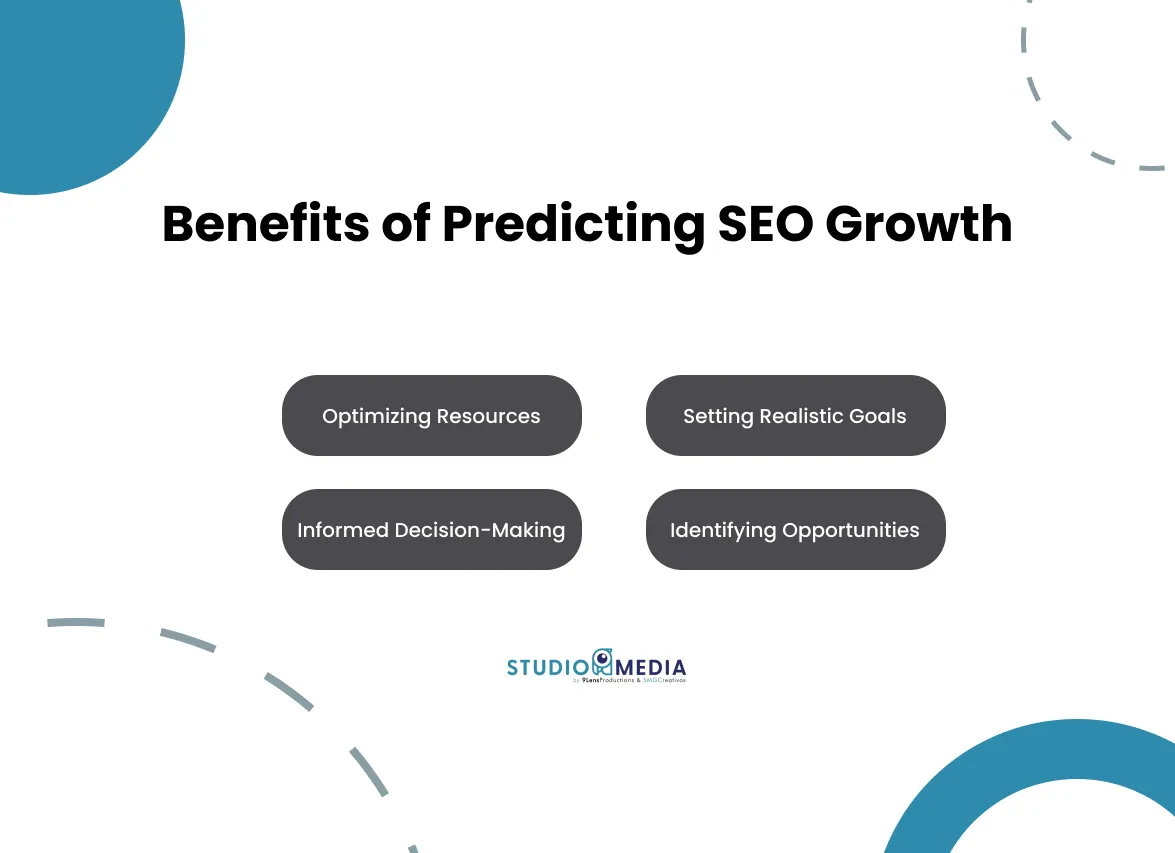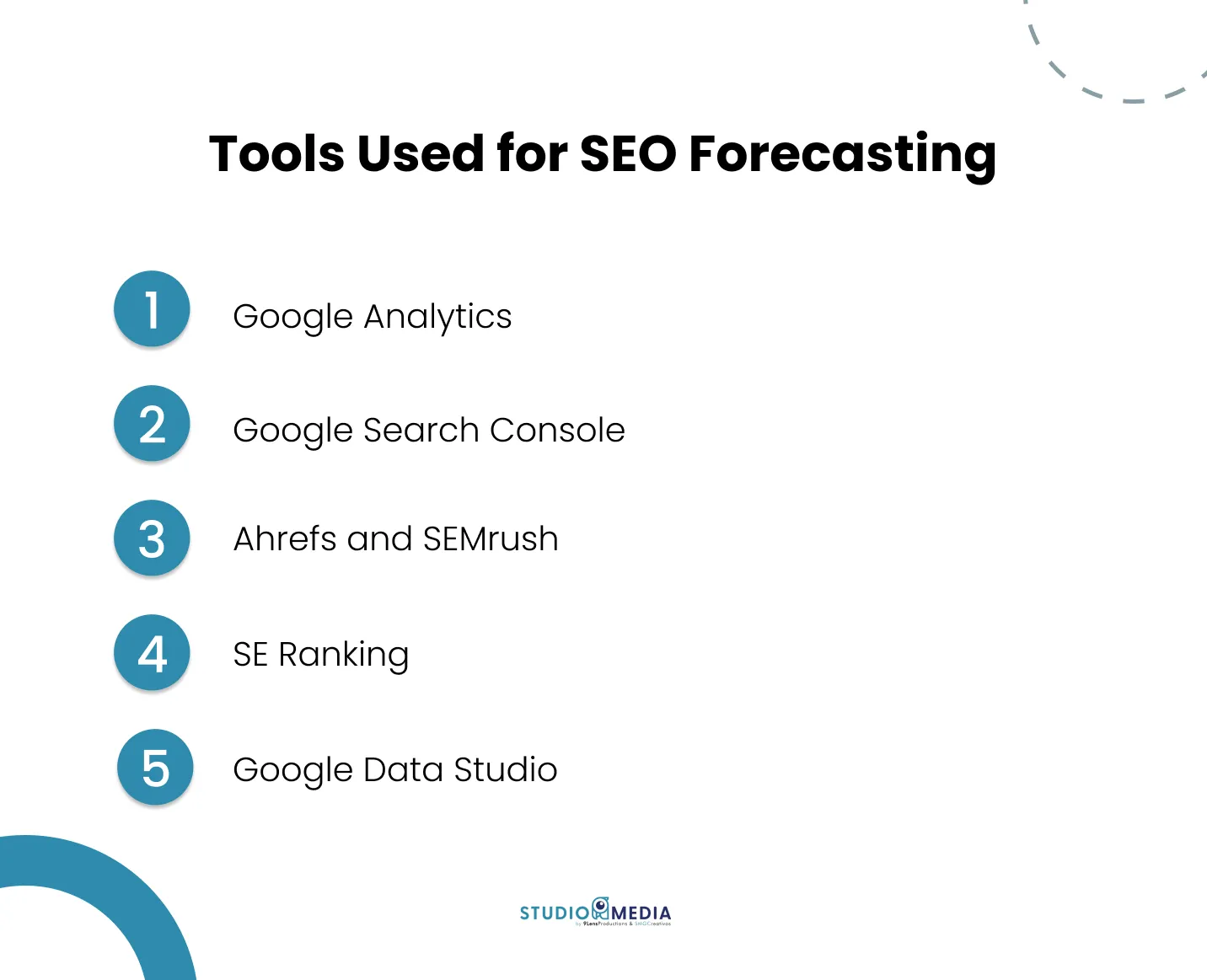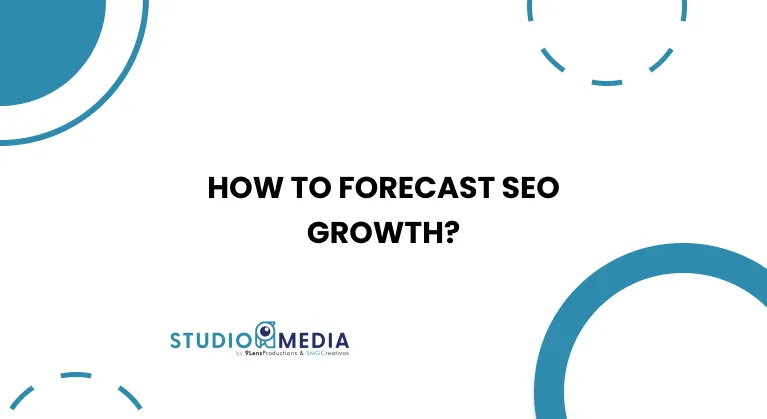1. What is SEO Forecasting?
SEO forecasting is a methodology used to predict the organic traffic growth of a website. It involves analyzing historical data, current trends, and external factors to estimate how SEO campaigns will perform in search engines over time. SEO forecasting plays a crucial role in strategic planning by allowing businesses to anticipate results, allocate resources effectively, and adjust their SEO strategies based on realistic expectations.
For instance, if your website has seen a consistent 10% growth in organic traffic over the last six months, SEO forecasting will help you predict whether this growth will continue, slow down, or require adjustments in your SEO tactics.
2. Importance of SEO Forecasting
SEO forecasting is crucial because it provides clarity on the expected outcomes of SEO efforts, helping stakeholders set realistic goals. Here’s why it matters:
- Justifying Investments: Forecasting helps demonstrate the potential return on investment (ROI) of SEO campaigns. By predicting traffic growth, you can show decision-makers how SEO contributes to revenue generation, brand visibility, and long-term success.
- Strategic Planning: Forecasting allows businesses to align their SEO activities with broader business goals. By predicting the organic traffic growth, companies can set specific, achievable targets and adjust their resources accordingly.
- Proactive Decision-Making: SEO forecasting helps anticipate potential challenges or opportunities in the market. Instead of reacting to traffic fluctuations after they occur, businesses can plan in advance, staying ahead of competitors.
From my experience, SEO forecasting not only optimizes resource allocation but also provides clarity when pitching campaigns to upper management or clients. It’s a powerful way to link SEO activities directly to business outcomes.
3. Difficulty of Forecasting SEO Growth
Forecasting SEO growth can be difficult due to several unpredictable factors. These challenges include:
- Algorithm Changes: Search engines, particularly Google, regularly update their algorithms. These changes can significantly affect website rankings without warning, making it challenging to predict long-term SEO performance accurately.
- External Factors: Competitors, market shifts, and user behavior can all impact SEO results. For example, a competitor might increase their SEO investment, affecting your rankings. Additionally, global events like the COVID-19 pandemic have shifted user search behavior dramatically, disrupting forecasts.
- Keyword Volatility: The competition for specific keywords can fluctuate, causing changes in ranking positions. The level of interest in certain keywords may also rise or fall based on trends.
- Data Quality: Forecasting relies heavily on historical data. If the data is inconsistent or lacks sufficient volume, it’s difficult to make accurate predictions. This is why SEO forecasting is more reliable when backed by a robust set of data.
4. How to Forecast SEO Growth?
Forecasting SEO growth involves several important steps to create accurate projections:
- Analyze Historical Data: Reviewing past performance metrics such as organic traffic, keyword rankings, and conversions helps identify trends and patterns. This provides a foundation for predicting future growth.
- Use Predictive Models: Employ statistical models and algorithms like linear regression, time-series analysis, or ARIMA (AutoRegressive Integrated Moving Average) to project future SEO performance based on historical data.
- Evaluate Competitors: Competitor analysis is critical. By understanding how your competitors perform in search rankings and their SEO strategies, you can better assess opportunities or threats to your own growth.
- Incorporate External Factors: Consider outside influences such as changes in industry trends, market demands, or economic factors that could impact your SEO performance.
- Simulate Scenarios: Create best-case, worst-case, and neutral scenarios to understand how different variables (like budget changes or algorithm updates) may impact your SEO outcomes.
This structured approach will give you a clearer picture of your potential SEO growth and allow you to make informed decisions about your SEO strategy.
5. Benefits of Predicting SEO Growth
Predicting SEO growth provides numerous advantages, especially in resource optimization and strategic planning:
- Optimizing Resources: With accurate predictions, businesses can allocate budgets and time to the strategies that promise the highest returns, avoiding wasted resources on ineffective tactics.
- Setting Realistic Goals: SEO forecasting helps establish measurable and attainable objectives, reducing the risk of over-promising and under-delivering on SEO campaign results.
- Informed Decision-Making: Forecasts provide a data-backed foundation for making decisions on where to focus SEO efforts, whether it’s content creation, link building, or technical SEO.
- Identifying Opportunities: Forecasting enables companies to detect new opportunities, such as emerging keywords or trends, that can be capitalized on early for competitive advantage.
In my experience, SEO forecasting is a powerful tool for spotting shifts in the market before they happen, allowing you to make timely adjustments that keep your SEO performance strong.

6. Methods to Forecast SEO Growth
Several methods are commonly used to predict SEO growth accurately:
- Trend Analysis: Look at historical traffic patterns and search trends to estimate how they may evolve. This is particularly useful for understanding seasonal fluctuations or shifts in keyword popularity.
- Statistical Models: Techniques like linear regression or ARIMA are frequently used to predict growth based on past performance. These models help identify relationships between variables such as content updates, link-building efforts, and traffic changes.
- Machine Learning: Advanced algorithms can analyze large datasets to uncover patterns that may not be visible through traditional methods. Machine learning models improve accuracy over time as they learn from new data inputs.
- Competitor Analysis: By benchmarking your performance against competitors, you can better understand where opportunities for growth may lie. For instance, observing a competitor’s keyword ranking can help you adjust your own content strategy.
- Scenario Simulations: Build projections based on potential changes in strategy, such as increasing content output or modifying the focus of your keyword optimization efforts. Simulating multiple outcomes allows you to prepare for different situations.
These methods are often most effective when used together, as each offers a unique perspective on future SEO performance.
7. Tools Used for SEO Forecasting
There are several tools that can help you forecast SEO growth effectively:
- Google Analytics: This tool provides in-depth data on user behavior, traffic sources, and conversions. It’s essential for understanding how past SEO efforts have impacted traffic and engagement.
- Google Search Console: Offers insights into keyword rankings, search impressions, and click-through rates (CTR). It helps identify issues that might be affecting organic performance.
- Ahrefs and SEMrush: These tools are invaluable for competitor analysis, backlink tracking, and keyword monitoring. They also provide historical data on rankings, helping with trend analysis.
- SE Ranking: This platform provides keyword tracking, SEO audits, and competitor analysis, offering a comprehensive view of your SEO performance over time.
- Google Data Studio: A powerful tool for visualizing SEO data and creating customizable dashboards that help with SEO forecasting and performance tracking.
These tools not only assist in data collection and analysis but also help you keep track of the ongoing progress of your SEO efforts, ensuring that forecasts remain accurate over time.

8. Key Metrics for SEO Forecasting
When conducting SEO forecasting, focusing on the right metrics is crucial for predicting future performance:
- Organic Traffic: The number of visitors who land on your site through organic search. This is a primary metric for measuring SEO success.
- Conversion Rate: The percentage of organic visitors who complete a desired action, such as making a purchase or signing up for a newsletter. Conversion rates provide insight into the quality of the traffic you’re attracting.
- Click-Through Rate (CTR): The ratio of users who click on your site from search engine results. A higher CTR suggests that your meta titles and descriptions are compelling.
- Time on Site: How long users spend on your website. A longer time on site indicates that users find your content valuable and engaging.
- Backlinks: The number and quality of inbound links from other websites. Backlinks are a critical factor in SEO rankings, and tracking their growth can help forecast SEO improvements.
These metrics provide a comprehensive view of how your SEO efforts are contributing to overall website performance.
9. Why You Should Forecast SEO Growth?
There are several compelling reasons to forecast SEO growth:
- Optimizing Resources: Forecasting helps you allocate budgets and resources more efficiently by focusing on the strategies that are likely to deliver the best results.
- Setting Clear Expectations: Forecasting allows stakeholders to have realistic expectations regarding the outcomes of SEO efforts, avoiding frustration or disappointment later on.
- Better Decision-Making: With data-backed projections, you can make informed decisions about where to focus SEO efforts, whether that’s content creation, link building, or technical optimizations.
10. Strategies to Improve SEO Forecast Accuracy
To enhance the accuracy of your SEO forecasts, it’s important to follow these strategies:
- Use Reliable Data: Ensure that the data you use for forecasting is accurate and up-to-date. Incomplete or outdated data can lead to incorrect predictions.
- Regularly Update Forecasts: SEO is dynamic, and forecasts should be regularly updated to reflect the latest data and trends. Regularly adjusting predictions based on new information will improve forecast accuracy.
- Apply Advanced Models: Using statistical or machine learning models can provide more accurate forecasts by accounting for complex patterns in the data.
- Evaluate External Factors: Consider outside influences such as algorithm updates or shifts in consumer behavior that could affect SEO performance.
11. When to Do SEO Forecasting: Key Reasons and Moments
There are several moments when conducting SEO forecasting is particularly valuable:
- Launching a New SEO Campaign: Forecasting allows you to set clear expectations and define the potential ROI of new initiatives.
- Website Redesign: When you make significant changes to your website’s design or structure, forecasting can help predict how these changes will impact your SEO performance.
- Significant Algorithm Updates: After major search engine updates, forecasting helps you understand how rankings might shift and what adjustments are necessary.
- Market Expansion: Entering a new market or targeting a new audience requires careful forecasting to estimate potential traffic growth and keyword opportunities.
12. Common Mistakes When Forecasting SEO Growth
Avoid these common mistakes when forecasting SEO growth:
- Underestimating the Time Required: SEO is a long-term strategy, and results often take months to manifest. Underestimating the time required for growth can lead to unrealistic expectations.
- Ignoring External Factors: Failing to account for changes in the industry, algorithm updates, or shifts in consumer behavior can lead to inaccurate forecasts.
- Overemphasizing a Single Metric: Focusing too much on one metric, such as organic traffic, without considering conversions or engagement, can provide a skewed picture of success.
- Not Regularly Reviewing Forecasts: Forecasts should be reviewed and adjusted regularly as new data becomes available. Static projections can quickly become outdated.
13. How to Align SEO Forecasting with Business Objectives?
SEO forecasting should be aligned with business objectives to ensure SEO efforts contribute directly to company goals:
- Define Relevant KPIs: Align SEO key performance indicators (KPIs) with business goals such as revenue growth, lead generation, or brand awareness. For example, focus on increasing traffic to key landing pages that drive conversions.
- Impact on ROI: Use forecasting to estimate how SEO efforts will impact the company’s bottom line. Calculate the potential financial returns of increased organic traffic.
- Collaboration Across Departments: Ensure that your SEO forecasts are aligned with initiatives from other departments, such as marketing, sales, and product development. This ensures that SEO contributes to the company’s overall success.
- Adjust Strategies Based on Results: As forecasts are monitored, adjust SEO strategies to stay aligned with evolving business objectives.
14. How SEO Forecasting Influences the Conversion Funnel?
SEO forecasting plays a key role in optimizing the conversion funnel, from driving traffic to converting visitors into customers:
- Top-of-Funnel (Attraction): Forecasting allows you to estimate how many users may enter the funnel through organic search. This helps plan content strategies aimed at attracting potential customers in the awareness stage.
- Mid-Funnel (Consideration): Predicting how traffic will engage with your website allows you to optimize pages for conversion, ensuring that users move further down the funnel.
- Bottom-of-Funnel (Decision): Forecasting conversions based on traffic and engagement metrics enables you to fine-tune your SEO strategy to meet sales or lead generation goals.
- Segmenting Traffic by Value: Not all traffic has the same value. Forecasting helps identify which traffic segments are most likely to convert, allowing you to prioritize resources where they will have the highest impact.
15. Impact of Google Updates on SEO Forecasting
Google frequently updates its algorithm, which can significantly impact SEO forecasting. Here’s how to manage the impact of updates:
- Major Algorithm Updates: These updates can drastically alter the ranking landscape. SEO forecasting helps prepare for potential shifts and adjust strategies in response.
- Penalties and Boosts: Algorithm changes can result in penalties or improvements in rankings. Being proactive and flexible with SEO strategies can help mitigate negative impacts or capitalize on positive changes.
- Adapting to Algorithmic Changes: Forecasting allows businesses to prepare for potential drops in traffic after an update and develop contingency plans to recover rankings.
- Historical Analysis of Updates: Reviewing how previous algorithm updates affected your site can provide valuable insights for future forecasting and strategy adjustments.
Conclusion
SEO forecasting is an indispensable tool for any successful SEO campaign. By predicting organic growth, you not only optimize resources and strategies but also set clear expectations that allow for better decision-making. To ensure forecast accuracy, it is essential to use the right tools, focus on key metrics, and adjust forecasts based on changes in the SEO environment. With proper planning and a flexible approach, SEO forecasting can make the difference between success and stagnation in a search engine optimization campaign.







